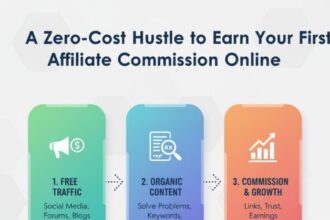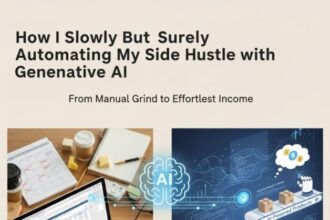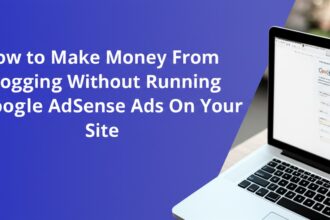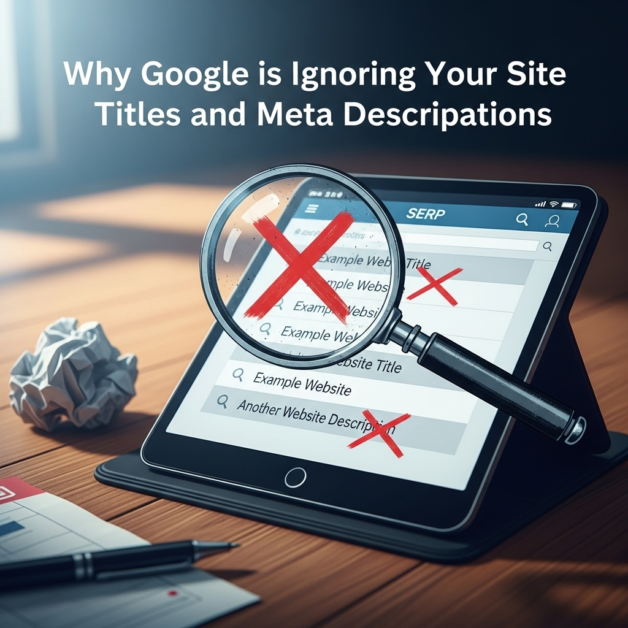How to Create a Blog Niche That Attracts AdSense Ads
My blog was about everything, which meant it was about nothing.
Honestly. One day, it was a post about the weird-looking bird I saw on my windowsill. The next day, I was trying to review a video game I was terrible at. The day after that? My grand, earth-shattering thoughts on the best way to reheat pizza. (The oven. It’s the oven.) My blog was basically the inside of my brain dumped onto a webpage. A chaotic, disorganized, and slightly sticky mess.
And my AdSense dashboard? It was a ghost town. It was so quiet in there, you could hear the digital crickets chirping. Most days, it sat at a cool, clean $0.00. On a really good day, I might see a whopping nine cents. Thrilling stuff.
I was stuck. Totally frozen. Everyone, and I mean everyone, chants the same mantra online: “You need a niche!” But saying that is like telling a lost person to “just pick a direction!” Okay, great, but which one? What if it’s the wrong one? The sheer terror of committing to a single topic was so overwhelming that I just kept writing about nothing instead. It felt safer to fail quietly than to try and fail spectacularly. But I was so tired of failing. I had to figure out how to create a blog niche that attracts AdSense ads, for real this time.
So I did what any desperate person does. I ignored my responsibilities, brewed a truly irresponsible amount of coffee, and fell down the weirdest, most frustrating rabbit hole of my life.
My First Steps Into the Bizarre World of Niches
My journey started, as they all do, with that hopeful little search query: “How to find a blog niche.”
It was a mistake. A huge mistake.
Instantly, my screen was flooded with an absolute tsunami of lists. “The 200 Best Niches to Start in 2025!” “50 Niches You’d Be an Idiot Not to Try!” “The One Niche That Made My Uncle’s Cousin a Bazillionaire!”
My brain just… shut down. It was information overload in its purest, most brutal form.
One minute I was convinced I should start a blog about sustainable alpaca farming. The next, I was looking into the profit potential of unicycle maintenance. I didn’t know anything about alpacas OR unicycles. The whole process of niche selection was making me feel incredibly stupid. All these sites talked about finding profitable niches like it was as easy as picking a shirt out of your closet. For me, it felt like I was being asked to perform open-heart surgery. On myself.
The Battle in My Brain: Passion vs. Profit
It felt like I was caught in a tug-of-war.
In one corner, you had the “passion” gurus. They were the gentle, artsy types who spoke in hushed tones about “following your bliss.” They’d say things like, “Write from the heart, and the audience will find you.” Sounds lovely, doesn’t it? My junk-drawer blog was me following my bliss. My bliss was apparently worth about nine cents a day.
In the other corner were the “profit” bros. These were the guys with spreadsheets for souls who talked about things like CPC and RPM and other scary acronyms. They’d insist that passion was for suckers. “Who cares if you like it? The keyword ‘auto insurance quotes’ is worth a fortune! Go write about that!”
So what was I supposed to be? A blissfully broke artist or a miserably rich robot?
I actually tried being the robot. I swear. I spent an entire weekend trying to plan out a blog about… compliance software for small businesses. My eyes glazed over just typing that sentence. The work felt like chewing on cardboard. I had no interest, no original thoughts, nothing. It was a complete non-starter. My heart, my brain, my entire being was rejecting it.
My Weird Fishing Analogy
I was about to give up entirely. Then one night, while staring at the ceiling and questioning all my life choices, a weird analogy stumbled into my brain.
Choosing a niche is just like deciding where to go fishing.
My first blog, my glorious junk-drawer blog, was like trying to fish in a rain puddle in the middle of a shopping mall parking lot. I had my gear, I was really into it, but there were simply no fish. End of story.
The “follow your passion” advice, I realized, is like fishing in a gorgeous, picturesque mountain lake that you later discover has been fishless for fifty years. You love the scenery, but you’re not going to catch dinner.
The “chase the profit” advice is like deciding you want to catch great white sharks, so you paddle out into the middle of the ocean on a pool float. Sure, that’s where the prize is, but you’re going to get eaten. You’re completely unprepared and out of your league.
The goal isn’t just to find water. It’s to find a fishable lake that you actually enjoy visiting, that has the kind of fish you know how to catch, and that isn’t already surrounded by a thousand professional fishermen with giant nets. I had to find my own fishing spot.
Turns Out, Most “Niche Advice” is Kinda Garbage
This goofy little fishing analogy was the key. It was the lens I needed to see through all the online noise. And once I had it, I started realizing something important: a lot of the common wisdom out there is either just plain wrong or so simplified it’s dangerous.
This was actually a huge relief. It meant I wasn’t an idiot for being paralyzed. I was paralyzed because I was trying to follow a bunch of bad maps that were all leading me to different, terrible places. Unlearning is so much harder than learning, but I had to do it.
“You Need a Totally Unique, Untapped Idea!” Uh, No You Don’t.
This was myth #1 and it was the one that tortured me the most. I was convinced I had to invent something from scratch. A blog about the social habits of garden gnomes. A review site for sporks.
I spent weeks trying to brainstorm an idea so unique nobody had ever thought of it.
But here’s the terrifying truth: if nobody is talking about something, it’s probably because nobody is looking for it. A completely empty playing field is not an opportunity. It is a wasteland.
Competition is a good thing. Let me say that again. Competition is a sign of life. It’s proof that people care about this topic. It’s proof that there’s an audience to be had and money to be spent. The problem isn’t keyword competition; the problem is trying to compete head-to-head with the big sharks in the deep water.
The goal isn’t to discover a whole new ocean. It’s to find your own quiet little cove on the edge of that ocean. The big guys can have the main beach. You just need a little spot you can call your own.
“It HAS to Be Your One True Passion!” Or… Does It?
Ah, the passion myth. This one sounds so good because we all want to believe it. We want to believe that our deepest passion will also make us rich.
And for some lucky people, it does. But for most of us, our passions are weird, scattered, or not very commercial. Like my passion for reheating pizza.
What I started to discover from the real stories I dug up is that you don’t need all-consuming, fiery passion. Sometimes, you just need a healthy dose of curiosity. You just have to be interested enough to be willing to learn.
I found a story about a woman who started a six-figure blog about… cleaning schedules. Do you think she was born with a passionate fire in her soul for dusting and organizing? I doubt it. But she was passionate about bringing order to chaos and helping overwhelmed moms feel more in control. She found a problem she was curious about solving, and she became the best at it.
This blew my mind. The passion can be for the helping, not for the thing. This opens up a million new doors. I didn’t have to pick from my existing list of hobbies. I could pick a problem.
“Do Your Research, Pick Your Niche, and You’re Done!” Wrong again.
This one is subtle but deadly. I fell for it. I did a bit of research, found an idea I thought might work, and dove in. I wrote five or six posts that I was sure my new, theoretical audience would love.
Crickets. Again.
I thought the research phase was a single step. A box to be checked. But it’s not. Audience research is not a task; it’s a relationship. It’s a constant, ongoing conversation. An insightful report from the Pew Research Center about online communities really drives this home, showing how dynamic and specific these groups are.
Your audience’s needs change. New problems crop up. New questions arise. The real pros don’t just assume they know what their audience wants. They live where their audience lives. They read the comments, they hang out in the forums, they listen, listen, listen. They let their audience guide their content strategy. It’s a dance. And I had been trying to waltz all by myself.
The Doodling on a Napkin That Changed My Brain
I was so tired. My brain felt like a bowl of scrambled eggs. Passion, profit, keywords, competition… I was trying to juggle all these concepts, and I was dropping everything. I was looking for a single, perfect answer, “the” niche.
There is no “the” niche.
The moment it all finally clicked for me wasn’t some grand epiphany. It was me, at my messy kitchen table, literally drawing circles on a stained napkin. I drew three big, overlapping circles.
A Venn diagram. The kind from middle school math class.
And suddenly, my entire brain unscrambled. A good niche isn’t a point on a map. It’s the tiny, magical spot where those three circles overlap.
I Was Looking For an Answer. I Needed to Find an Intersection.
For weeks, I’d been treating this like a multiple-choice test where only one answer was correct. But it wasn’t.
Here are the three circles I drew on that napkin:
Circle #1: Stuff I Don’t Hate. This is the “passion” circle, but I’ve re-named it. It’s not about what I love. It’s about what I’m curious about. What could I spend a year learning about and writing about without wanting to fake my own death and flee the country? It’s a much more forgiving question.
Circle #2: Problems People Actually Have. This is the audience circle. Are there real human beings out there who are losing sleep over this topic? Are they desperately typing questions into Google about it? Are there forums filled with people complaining and asking for help?
Circle #3: Signs of Life (aka Money). This is the profit circle. But it’s more about just finding a commercial ecosystem. Are there companies already paying for ads in this space? Are there products being sold? Is there an industry, big or small, that serves this audience?
My mistake had been trying to live in just one circle. The junk-drawer blog was 100% in the “Stuff I Don’t Hate” circle. Total failure. My brief attempt at a finance blog was 100% in the “Money” circle. Even bigger failure.
The gold isn’t in any of the circles. It’s in the overlap. It’s the niche validation process of making sure that you have a piece of all three. That’s your niche. It’s where your curiosity meets a real audience’s needs and a viable market. And as I wrote in my post, [How Three Circles on a Napkin Saved My Blog], it’s this combination that creates something sustainable.
The Plot of Land Metaphor
The Venn diagram completely changed how I saw this. I wasn’t trying to find a treasure chest anymore. I was trying to find a good plot of land to start a small farm.
Your interest is you, the farmer. You gotta be willing to get your hands dirty every day. The audience’s problems are the fertile soil. Without a real need, nothing can grow. The profit potential is the road to the farmer’s market. If there’s no way to sell what you grow, your farm can’t survive.
You need all three. A farmer with no road is just a gardener. A farmer with barren soil gets frustrated and quits. And a fertile field with no farmer just gets overgrown with weeds. But when you find a place where all three exist? Now you can actually build something.
My Unofficial, Cobbled-Together Guide to Finding Your Plot of Land
So, this is it. This is my system. It’s not magic. It’s not a secret formula from a guru. It’s just the weird, messy process I use now to avoid falling back into the paralysis trap. It’s how I’m learning, step-by-step, to actually create a blog niche that attracts AdSense ads.
1. I Let My Brain Be Messy (The “Bucket List”)
First, I just brainstorm. I make a list of big, broad “curiosity buckets.” I don’t filter. I don’t judge. It’s a pure brain dump. Anything I wouldn’t mind spending a Saturday afternoon reading about goes on the list. Things like:
Home fermentation (like kimchi or kombucha)
Urban foraging
Building custom mechanical keyboards
Training a reactive dog
Backyard astrophotography with a smartphone
2. I Put on My Detective Coat (Problem Hunting)
Next, I take each bucket and I become a professional lurker. My only job is to find out if people are actually complaining about this stuff online. My best tools for this are real, human places.
Reddit: This is my number one tool. I go to the subreddit for the topic, and I sort by “New.” I’m looking for questions, frustrations, and cries for help.
Facebook Groups: I find a few dedicated groups for the topic and just read the posts for a few days. It’s a live focus group.
“VS” and “Alternative” Google Searches: I search for things like “[product A] vs [product B]” or “[brand] alternatives.” This shows me that people are stuck trying to make a decision, which is a problem I can help solve.
I am laser-focused on finding pain points.
3. I Look for Money Footprints (Commercial Intent)
Now, for every bucket that’s overflowing with real problems, I have to check for signs of a healthy commercial ecosystem. This is all about commercial intent.
The “Ad” Test: I do a few simple Google searches for problems in that niche. “How to fix…” “Best product for…”. Do ads pop up? This is a huge, flashing green light. It means companies are actively paying money to reach these people. A guide from an authoritative source like the Google Ads help center can show you how this auction works.
The Amazon Test: I go to Amazon and see what kinds of products are being sold. Are there books? Gadgets? Supplies? This helps me understand the physical (or digital) world of the niche.
The Affiliate Test: I check to see if popular blogs in the space are using affiliate links. You can often see this in their disclosure policies. It’s more proof that a market exists.
4. I Stake My Claim on a Tiny Corner
Okay, now I might have a winner. Let’s say my research showed a great intersection of interest, problems, and money around “Backyard astrophotography with a smartphone.”
Is that my niche? Nope. Still too big.
The final step is to niche down one last time. My goal is to serve a hyper-specific audience. So maybe my actual niche becomes “Astrophotography for apartment dwellers with smartphones.”
Now I have my tiny corner of the internet. And my whole job is to build topic authority right there. Every post is about this. How to deal with light pollution. The best apps for iOS. The best cheap tripods. Everything. I aim to own that corner. As I wrote in a previous post, [Why ‘Niching Down Until it Hurts’ is the Best Advice I Ever Took], this focus is your superpower.
So, Where Does That Leave Me?
I’m still me. I haven’t magically transformed into a blogging tycoon overnight. This stuff is hard, and it takes time. A lot of time.
But the paralysis is gone. That feeling of being a fraud is gone. That sense of hopelessness as I stared at my nine cents? Gone.
Because now I have a map. A messy, hand-drawn map on a coffee-stained napkin, maybe, but it’s a map nonetheless. I know that the goal isn’t to get lucky. The goal is to be helpful. The goal is to find that tiny plot of land where your curiosity can be used to solve someone else’s problem in a place where a market already exists.
My new blog is young. It’s small. But it feels solid. It has a purpose. I’m no longer just shouting into the void. I’m a farmer. A very tired, very caffeinated farmer, slowly planting seeds in my own little corner of the internet.
And honestly, it feels really, really good to be building something again.
What’s the one fear that’s been stopping you from picking your own plot of land?












































